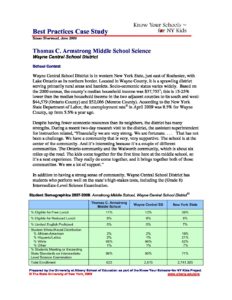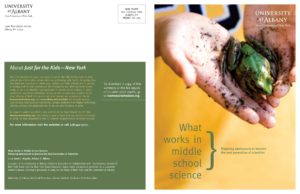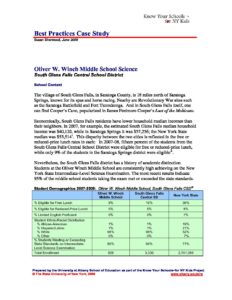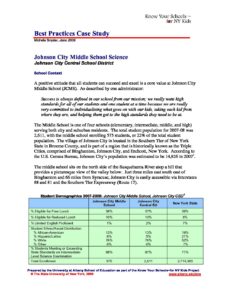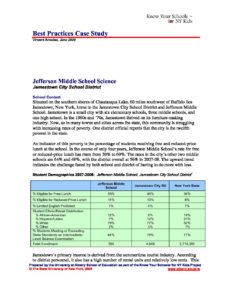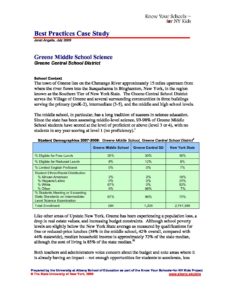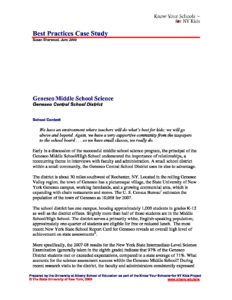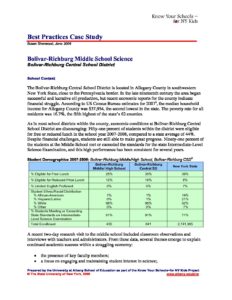Publication Year: 2009
This case study is part of an investigation of middle school science conducted in the 2008-2009 school year.
This case study was conducted in spring 2009 as one of a series of studies conducted by Just for the Kids~New York since 2005. For the study of middle school science, research teams investigated seven consistently higher-performing and three average-performing schools based on student performance on the New York State Intermediate-Level Science Examination in 2006, 2007, and 2008. Researchers used site-based interviews of teachers and administrators, as well as classroom observations and analyses of supportive documentations, to determine differences in practices between higher- and average-performing schools in the sample.
This is a case study investigating middle school science conducted in the 2008-2009 school year.
This case study was conducted in spring 2009 as one of a series of studies conducted by Just for the Kids~New York since 2005. For the study of middle school science, research teams investigated seven consistently higher-performing and three average-performing schools based on student performance on the New York State Intermediate-Level Science Examination in 2006, 2007, and 2008. Researchers used site-based interviews of teachers and administrators, as well as classroom observations and analyses of supportive documentations, to determine differences in practices between higher- and average-performing schools in the sample.
This case study is part of an investigation of middle school science conducted in the 2008-2009 school year.
This case study was conducted in spring 2009 as one of a series of studies conducted by Just for the Kids~New York since 2005. For the study of middle school science, research teams investigated seven consistently higher-performing and three average-performing schools based on student performance on the New York State Intermediate-Level Science Examination in 2006, 2007, and 2008. Researchers used site-based interviews of teachers and administrators, as well as classroom observations and analyses of supportive documentations, to determine differences in practices between higher- and average-performing schools in the sample.
This case study is part of an investigation of middle school science conducted in the 2008-2009 school year.
This case study was conducted in spring 2009 as one of a series of studies conducted by Just for the Kids~New York since 2005. For the study of middle school science, research teams investigated seven consistently higher-performing and three average-performing schools based on student performance on the New York State Intermediate-Level Science Examination in 2006, 2007, and 2008. Researchers used site-based interviews of teachers and administrators, as well as classroom observations and analyses of supportive documentations, to determine differences in practices between higher- and average-performing schools in the sample.
This case study is part of an investigation of middle school science conducted in the 2008-2009 school year.
This case study was conducted in spring 2009 as one of a series of studies conducted by Just for the Kids~New York since 2005. For the study of middle school science, research teams investigated seven consistently higher-performing and three average-performing schools based on student performance on the New York State Intermediate-Level Science Examination in 2006, 2007, and 2008. Researchers used site-based interviews of teachers and administrators, as well as classroom observations and analyses of supportive documentations, to determine differences in practices between higher- and average-performing schools in the sample.
This case study is part of an investigation of middle school science conducted in the 2008-2009 school year.
This case study was conducted in spring 2009 as one of a series of studies conducted by Just for the Kids~New York since 2005. For the study of middle school science, research teams investigated seven consistently higher-performing and three average-performing schools based on student performance on the New York State Intermediate-Level Science Examination in 2006, 2007, and 2008. Researchers used site-based interviews of teachers and administrators, as well as classroom observations and analyses of supportive documentations, to determine differences in practices between higher- and average-performing schools in the sample.
This case study is part of an investigation of middle school science conducted in the 2008-2009 school year.
This case study was conducted in spring 2009 as one of a series of studies conducted by Just for the Kids~New York since 2005. For the study of middle school science, research teams investigated seven consistently higher-performing and three average-performing schools based on student performance on the New York State Intermediate-Level Science Examination in 2006, 2007, and 2008. Researchers used site-based interviews of teachers and administrators, as well as classroom observations and analyses of supportive documentations, to determine differences in practices between higher- and average-performing schools in the sample.
This case study is part of an investigation of middle school science conducted in the 2008-2009 school year.
This case study was conducted in spring 2009 as one of a series of studies conducted by Just for the Kids~New York since 2005. For the study of middle school science, research teams investigated seven consistently higher-performing and three average-performing schools based on student performance on the New York State Intermediate-Level Science Examination in 2006, 2007, and 2008. Researchers used site-based interviews of teachers and administrators, as well as classroom observations and analyses of supportive documentations, to determine differences in practices between higher- and average-performing schools in the sample.
This presentation discusses the best practice research findings from a study of middle schools. It also offers free resources to inform continuous school improvement efforts in the future.
2009 What Makes Middle Schools Work - Five Keys to Success
This presentation discusses the best practice research findings from a study of middle schools. It also offers free resources to inform continuous school improvement efforts in the future.
This presentation offers best practices across higher performing schools (elementary, middle and high). Key findings include that higher performing schools embrace a variety of data and culture of continuous improvement.
2009 Redefining Evidence of Success - Best Practices in NY
This presentation offers best practices across higher performing schools (elementary, middle and high). Key findings include that higher performing schools embrace a variety of data and culture of continuous improvement.

